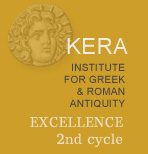Yeşildere / İbecikdere
5 |
Σιλλέας Νώ– νιος Κιβυράτης ἀνέστησεν ἁ– τῷ μνήμης ἕνεκεν |
Silleas Nonius, citizen of Cibyra, erected (this) for himself in memory.
Round molded funerary base from the woods N of İbecikdere (mostly referred to by locals as Yeşildere), 7 km NW of Boubon. Naour published this stone from the photographs and description provided by a resident of Çameli. Broken at the bottom.
Height: at least 82 cm; diameter: 42 cm; letters: 3 cm.
Naour 1976, p. 121, no. 13 (pl. VI.13); SEG 26 (1976-77), no. 1429; Milner 1998, p. 4, no. 2.13.
L. 1-2 : Σιλ(λ)έας: IGR III 486 (Oinoanda); Pugliese Carratelli 1965, p. 165, no. 9; p. 201, no. 27 (both Kos); Rehm 1958, 513 (Didyma); IK Kibyra I 327. It is uncertain whether the name is Greek or epichoric in origin. See Corsten's commentary in IK Kibyra I, p. 278. Νώνιος might be the Greek rendering of the Latin Nonius. This must be Silleas' second name, introduced without one of the expressions normally used to denote an alias (see no. 89). Cf. Naour, op. cit., p. 121. Κιβυράτης: since in none of the over 350 funerary inscriptions known from the territory of Cibyra does a citizen of this city use his ethnikon on his tombstone, Σιλλέας from Cibyra must have lived on the territory of Boubon. If this is true, and if we are not dealing with a pierre errante, then this inscription might provide a valuable indication of the extent of Boubon's territory to the North. However, according to Naour's source, the stone was found "au nord d'İbecikdere köyü, dans la montagne entre Çameli et Kibyra". It is doubtful that this information is accurate, because any place between Çameli and Cibyra would be too far north to be described in terms of its relation to İbecikdere. Lacking more precise information on the provenance of the stone, the most we might adduce from it is the possibility that Boubon's territory included regions to the E and maybe the NE of Çameli.
L. 3-4: ἁτῷ, ἑατῷ instead of αὑτῷ, ἑαυτῷ is not rare; see Naour, op. cit., p. 121 with n. 48, to which add IK Kibyra I 197; 298; 329; 346.
L. 5: Naour has χάριν, but ἕνεκεν can be seen clearly on the photograph.

